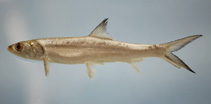http://www.fishbase.org/Summary/speciesSummary.php?genusname=Elops&speciesname=saurus ---> http://52.67.158.155/Summary/speciesSummary.php?genusname=Elops&speciesname=saurus
http://52.67.158.155/Summary/speciesSummary.php?genusname=Elops&speciesname=saurus ---> https://fishbase.net.br/Summary/speciesSummary.php?genusname=Elops&speciesname=saurus
https://fishbase.net.br/Summary/speciesSummary.php?genusname=Elops&speciesname=saurus ---> https://fishbase.net.br/summary/Elops-saurus.html
Elops saurus, Ladyfish : fisheries, gamefish, bait

You can
sponsor
this page
Common name (e.g. trout)
Genus + Species (e.g. Gadus morhua)
-

-
About this page
-
Languages
-
User feedbacks
-
Citation
-
Uploads
-
Related species
-


 Ladyfish
Add your observation in
Fish Watcher
Upload your
photos
and
videos
Ladyfish
Add your observation in
Fish Watcher
Upload your
photos
and
videos
Pictures
|
Videos |
Google image
 Elops saurus
Elops saurus
Picture by
NOAA\NMFS\Mississippi Laboratory
Teleostei (teleosts) >
Elopiformes
(Tarpons and tenpounders) >
Elopidae
(Tenpounders)
Etymology:
Elops:
Greek, ellops = a kind of serpent (Ref.
45335
)
.
More on author:
Linnaeus
.
Environment: milieu / climate zone / depth range / distribution range
Ecology
Marine; brackish; demersal; pH range: ? - 10.4; amphidromous (Ref.
51243
); depth range 0 - 50 m (Ref.
13325
). Subtropical; 11°C - 34°C (Ref.
127853
); 29°N - 17°S
Western Atlantic: Cape Cod (USA), Bermuda, and northern Gulf of Mexico to southern Brazil. Questionable occurrence records in the China (Ref.
52360
), Taiwan (47843), and Vietnam (Ref.
9706
,
46452
).
Length at first maturity / Size / Weight / Age
Maturity: L
m
?
range ? - ? cm
Max length : 100.0 cm TL male/unsexed; (Ref.
26340
); common length : 60.0 cm TL male/unsexed; (Ref.
3718
); max. published weight: 10.1 kg (Ref.
4699
)
Dorsal
spines
(total): 0;
Dorsal
soft rays
(total): 25-29;
Anal
spines
: 0;
Anal
soft rays
: 16 - 19;
Vertebrae
: 73 - 85. Scales small, more than 100 in lateral line. Gular plate narrow (Ref.
26938
). Silvery overall, with bluish on upper surface (Ref.
7251
). Branchiostegal rays: 26-33 (Ref.
4639
).
Occur in shallow neritic areas, over muddy bottoms (Ref.
5217
). Also found in brackish estuaries and juveniles are common in lagoons and hyper-saline bays (Ref.
5217
). Form large schools close to the shore (Ref.
9987
). Feed mainly on crustaceans and small fishes. Spawn in the open sea (Ref.
5217
). Larval development is represented by profound changes in body form accompanied by 2 periods of length increase, interspaced by a period of length decrease (Ref.
4639
). Noted for their habit of skipping along the surface of the water and for jumping after being hooked (Ref.
5521
). Marketed fresh, salted and frozen but considered a second rate food fish (Ref.
3718
).
Rhynchobothrium bulbifer
found in the viscera of the adult (Ref.
37032
).
Spawns offshore, the larvae drifting towards the coast where they shelter and grow (Ref.
9987
). Leptocephalus larvae are found in salinities as low as 0.0+ to 0.8 ppt (Ref.
75142
).
Robins, C.R. and G.C. Ray
, 1986. A field guide to Atlantic coast fishes of North America. Houghton Mifflin Company, Boston, U.S.A. 354 p. (Ref.
7251
)
IUCN Red List Status (Ref.
130435
)
Least Concern (LC)
; Date assessed:
30 March 2011
CITES
Not Evaluated
Not Evaluated
Threat to humans
Harmless
Human uses
Fisheries: minor commercial; gamefish: yes; bait: usually
FAO - Fisheries:
landings
; Publication:
search
|
FishSource
|
Sea Around Us
More information
Countries
FAO areas
Ecosystems
Occurrences
Introductions
Stocks
Ecology
Diet
Food items
Food consumption
Ration
Common names
Synonyms
Metabolism
Predators
Ecotoxicology
Reproduction
Maturity
Spawning
Spawning aggregation
Fecundity
Eggs
Egg development
Age/Size
Growth
Length-weight
Length-length
Length-frequencies
Morphometrics
Morphology
Larvae
Larval dynamics
Recruitment
Abundance
BRUVS
References
Aquaculture
Aquaculture profile
Strains
Genetics
Electrophoreses
Heritability
Diseases
Processing
Nutrients
Mass conversion
Collaborators
Pictures
Stamps, Coins Misc.
Sounds
Ciguatera
Speed
Swim. type
Gill area
Otoliths
Brains
Vision
Tools
E-book
|
Field guide
|
Length-frequency wizard
|
Life-history tool
|
Point map
|
Classification Tree
|
Catch-MSY
|
Special reports
Check for Aquarium maintenance
|
Check for Species Fact Sheets
|
Check for Aquaculture Fact Sheets
Download XML
Summary page
|
Point data
|
Common names
|
Photos
Internet sources
AFORO (otoliths)
|
Aquatic Commons
|
BHL
|
Cloffa
|
BOLDSystems
|
Websites from users
|
Check FishWatcher
|
CISTI
|
Catalog of Fishes
:
genus
,
species
|
DiscoverLife
|
ECOTOX
| FAO - Fisheries:
landings
; Publication:
search
|
Faunafri
| Fishipedia |
Fishtrace
| GenBank:
genome
,
nucleotide
|
GloBI
|
GoMexSI
(interaction data)
|
Google Books
|
Google Scholar
|
Google
|
IGFA World Record
|
MitoFish
|
National databases
|
Otolith Atlas of Taiwan Fishes
|
Public aquariums
|
PubMed
| Reef Life Survey | Socotra Atlas |
Tree of Life
| Wikipedia:
Go
,
Search
| World Records Freshwater Fishing |
Zoobank
|
Zoological Record
Estimates based on models
Preferred temperature (Ref.
123201
): 25 - 29.1, mean 28 °C (based on 1142 cells).
Phylogenetic diversity index (Ref.
82804
): PD
50
= 0.5176 [Uniqueness, from 0.5 = low to 2.0 = high].
Bayesian length-weight: a=0.00617 (0.00458 - 0.00830), b=2.94 (2.86 - 3.02), in cm total length, based on LWR estimates for this species (Ref.
93245
).
Trophic level (Ref.
69278
): 3.5 ±0.3 se; based on diet studies.
Resilience (Ref.
120179
): Medium, minimum population doubling time 1.4 - 4.4 years (K=0.22-0.3; tm=2).
Fishing Vulnerability (Ref.
59153
): High vulnerability (60 of 100).
Climate Vulnerability (Ref.
125649
): Very high vulnerability (88 of 100).
Price category (Ref.
80766
):
Low
.
Nutrients (Ref.
124155
): Calcium = 22.2 [10.7, 44.5] mg/100g; Iron = 0.569 [0.300, 0.970] mg/100g; Protein = 17.7 [15.5, 20.7] %; Omega3 = 0.15 [0.08, 0.27] g/100g; Selenium = 20.8 [10.2, 44.4] μg/100g; VitaminA = 34.3 [11.0, 111.0] μg/100g; Zinc = 0.654 [0.437, 1.015] mg/100g (wet weight); based on
nutrient studies.
Back to Search
Random Species
Back to Top
Accessed through:
Not available
FishBase mirror site :
Laguna, Philippines
Page last modified by :
mrius-barile
|